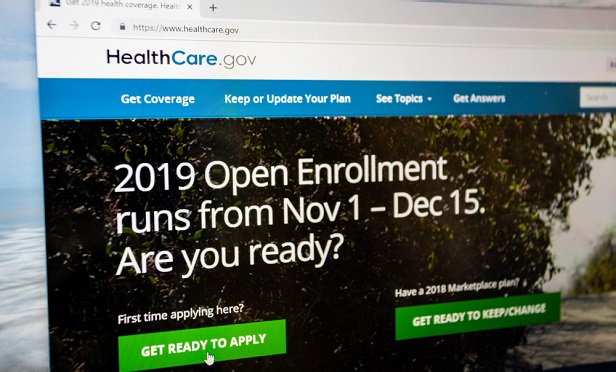 Theannual open-enrollment period for people who buy their owninsurance on ACA marketplaces ends Dec. 15 in most states.Enrollment has been sluggish this year compared to last.
Theannual open-enrollment period for people who buy their owninsurance on ACA marketplaces ends Dec. 15 in most states.Enrollment has been sluggish this year compared to last.
The woman arrived at the University of South Florida's navigatoroffice in Tampa a few weeks ago with a 40-page document describinga short-term health insurance plan she wasconsidering. She was uncomfortable with what the broker had saidabout the coverage, she told Jodi Ray, a health insurance navigator who helps peopleenroll in coverage, and she wanted help understanding it.
|The document was confusing, according to Ray, who overseesCovering Florida, the state's navigator program. It was hard todecipher which services would be covered.
|“It was like a bunch of puzzle pieces,” she said.
|Related: ACA markets seeing few new signups
|Encouraged by her wife, the woman eventually opted instead for amarketplace plan with comprehensive benefits.
|The annual open-enrollment period for people who buy their owninsurance on the Affordable Care Act's marketplaces ends Dec. 15 inmost states. Enrollment in states that use the federalhealthcare.gov platform has been sluggish this year compared tolast. From Nov. 1 through Dec. 1, about 3.2 million people had chosen plans for 2019. Comparedwith the previous year, that's about 400,000 fewer, or a drop ofjust over 11 percent.
|The wider availability of short-term plans is one big changethat has set this year's apart from past sign-up periods.
|Another is the elimination of the penalty for not having healthinsurance starting next year. The Congressional Budget Office hasestimated that as many as 3 million people who buy their owncoverage may give it up when they don't face a tax penalty. But experts who have studied health insurance enrollmentsay that surveys so far indicate that the penalty hasn't typicallybeen the pivotal factor in people's decision on whether to buyinsurance.
|They also caution against reading too much into the preliminaryenrollment totals.
|“There typically is a surge in enrollment at the end,” saidSabrina Corlette, research professor at Georgetown University'sCenter on Health Insurance Reforms. “It's hard to know whether itwill make up for the shortfall.”
|If they don't pick a new plan, people who are enrolled in a 2018marketplace plan may be automatically re-enrolled in their currentplan or another one that is similar when the open-enrollment periodends. About a quarter of people who have marketplace plans are reassignedin this way.
|Another factor that may be affecting enrollment is tighter federal funding for the health insurance navigators,like Jodi Ray in Tampa, who guide consumers through the complicatedprocess. With fewer experts available to answer questions and help fill outthe enrollment forms, consumers may fall through the cracks.
|Across the country, funding for navigators dropped from $36million in 2017 to $10 million this year. In Florida, federalfunding for the Covering Florida navigator program was slashed to$1.25 million this year from $4.9 million last year, Ray said. Theprogram was the only one to receive federal funding in the statethis year.
|The Covering Florida program reduced the number ofopen-enrollment navigators to 59 this year, a nearly 61 percentdrop, Ray said. Navigators this year are available in only half ofFlorida counties; the organization is offering telephone assistanceand virtual visits to people in counties where they can't offerin-person help.
|“It's all we can do,” Ray said. So far, the group's navigatorshave enrolled about half the number of people this year as they hadlast year.
|It's unclear the extent to which the Trump administration'sefforts to reduce health care costs by expanding access toshort-term plans is affecting marketplace plan enrollment.
|These plans, originally designed to cover people who expected tobe out of an insurance plan for a short time, such as when theychange jobs, can be less expensive. Unlike marketplace plans,short-term plans don't have to provide comprehensive benefits orguarantee coverage for people who have preexisting medicalconditions.
|The Obama administration limited short-term plans to athree-month term. But in August, the federal government issued a rule that allowed their sale with initial terms of upto a year, and the option of renewal for up to three years.
|Ten states either ban short-term plans or restrict them to terms of less thanthree months, said Sarah Lueck, a senior policy analyst at theCenter on Budget and Policy Priorities.
|Many people are seemingly not focused on their options thisopen-enrollment season, however. According to a recent survey, about half of adults under age 65 who wereuninsured or who buy their own coverage said they planned to buy aplan for 2019. But only 24 percent of people in that age group saidthey knew what the deadline was to enroll in health insurance,according to the Kaiser Family Foundation's November healthtracking poll.
|Kaiser Health News isa nonprofit news service covering health issues. It is aneditorially independent program of the Kaiser Family Foundation,which is not affiliated with Kaiser Permanente.
|Read more:
Complete your profile to continue reading and get FREE access to BenefitsPRO, part of your ALM digital membership.
Your access to unlimited BenefitsPRO content isn’t changing.
Once you are an ALM digital member, you’ll receive:
- Critical BenefitsPRO information including cutting edge post-reform success strategies, access to educational webcasts and videos, resources from industry leaders, and informative Newsletters.
- Exclusive discounts on ALM, BenefitsPRO magazine and BenefitsPRO.com events
- Access to other award-winning ALM websites including ThinkAdvisor.com and Law.com
Already have an account? Sign In
© 2024 ALM Global, LLC, All Rights Reserved. Request academic re-use from www.copyright.com. All other uses, submit a request to [email protected]. For more information visit Asset & Logo Licensing.








